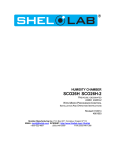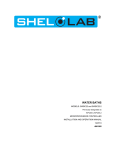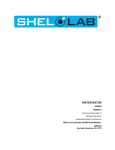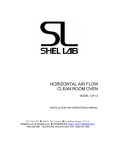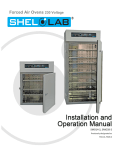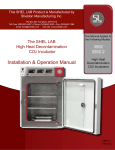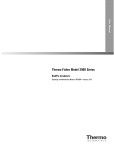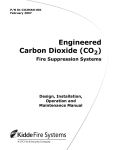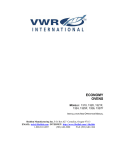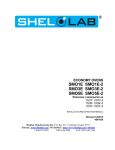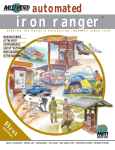Download Old Style Manual SGO3 SGO3-2 (4861567)
Transcript
MICROPROCESSOR CONTROLLED OVEN SGO3 SGO3-2 PREVIOUSLY DESIGNATED CE3G CE3G-2 Revised 12/2013 4861567 INSTALLATION AND OPERATION MANUAL Sheldon Manufacturing Inc. P.O. Box 627 Cornelius, Oregon 97113 EMAIL: [email protected] INTERNET: http://www.Shellab.com/~Shellab 1-800-322-4897 (503) 640-3000 FAX (503) 640-1366 TABLE OF CONTENTS SECTION 1.0 RECEIVING AND INSPECTION SECTION 2.0 GRAPHIC SYMBOLS SECTION 3.0 INSTALLATION SECTION 4.0 PRECAUTIONS SECTION 5.0 CONTROL PANEL OVERVIEW SECTION 6.0 OPERATION SECTION 7.0 MAINTENANCE SECTION 8.0 TROUBLESHOOTING SECTION 9.0 PARTS LIST UNIT SPECIFICATIONS SCHEMATICS These units are TUV CUE listed as gravity convection ovens for professional, industrial, or educational use where the preparation or testing of materials is done at approximately atmospheric pressure and no flammable, volatile, or combustible materials are being heated. These units have been tested to the following requirements: CAN/CSA C22.2 No. 61010-1:2012 CAN/CSA C22.2 No. 61010-2-010 + R:2009 UL 61010-1:2004 + R:2005-07 + R:2008-10 UL 61010A-2-010:2002 UL 61010-1:2012 EN 61010-1:2010 EN 61010-2-010:2003 IEC 61010-1:2010 IEC 61010-2-010:2003 2 1 Section RECEIVING AND INSPECTION Your satisfaction and safety require a complete understanding of this unit. Read the instructions thoroughly and be sure that all users are given adequate training before attempting to use this unit. Note: This equipment must be used only for its intended purpose; any alterations or modifications will void your warranty. 1.1 Inspection: The carrier, when accepting shipment, also accepts responsibility for safe delivery and is liable for loss or damage claims. On delivery inspect for visible exterior damage, note and describe on the freight bill any damage found and enter your claim on the form supplied by the carrier. 1.2 Inspect for concealed loss or damage on the unit itself, both interior and exterior. If any, the carrier will arrange for official inspection to substantiate your claim. 1.3 Accessories: Verify that your accessory package is complete. All units should have a set of four (4) Leveling feet, two (2) shelves and eight (8) shelf clips. 1.4 Return Shipment: Save the shipping crate until you are sure all is well. If for any reason you must return the unit, contact your customer service representative for authorization and supply data plate information. Make sure to include the model and unit serial number. The service representatives will furnish you with a return authorization number and address for return. Note: Make sure this return authorization number appears on the unit packaging and shipping papers. Units returned without proper authorization may not be accepted at the factory. For information on where to contact Customer Service please see the manual cover. 3 2 Section GRAPHIC SYMBOLS Your oven has been provided with a display of graphic symbols which should help in identifying the use and function of the available user adjustable components. Symbol Identification Indicates that you should consult your operator’s manual for further instructions. Indique que l'opérateur doit consulter le manuel d'utilisation pour y trouver les instructions complémentaires. Indicates “Temperature” Repère "température" Indicates “Overtemperature Protection” Signale un "dépassement de température" Indicates “AC Power” Repère "secteur AC" Indicates "Timer". Repère "minuteur" Indicates “Protective Earthground” Repère de la "terre de protection" C Indicates "Degrees Celsius" Repère "degrés Celsius" Indicates “Manually Adjustable” Signale un élément "réglable manuellement" Indicates “Potential Shock Hazard” behind partition Signale un "risque potentiel d'électrocution" au-delà de la cloison. Indicates “Unit should be recycled” (Not disposed of in land-fill) Indique “l’appareil doit être recyclé“ (Ne pas jeter dans une décharge) 4 3 Section INSTALLATION Local city, county or other ordinances may govern the use of this equipment. If you have any questions about local requirements, please contact the appropriate local agency. Installation may be performed by the end user. Under normal circumstance this unit is intended for use indoors, at room temperatures between 5 and 40 C, at no greater than 80% Relative Humidity ( at 25C ) and with a supply voltage that does not vary by more than 10%. Customer service should be contacted for operating conditions outside these limits. 3.1 Power Source: Check the data plate for voltage and ampere requirements before making a connection. If the requirements match your power source, plug the power cord into a grounded outlet. VOLTAGE SHOULD NOT VARY MORE THAN 10% FROM THE DATA PLATE RATING. These units are intended for a 50/60 Hz application. We recommend a separate circuit to prevent loss of product due to overloading or circuit failure. Electrical supply to the unit must conform to all national and local electrical codes. 3.2 3.3 3.4 3.5 3.6 Location: When selecting a site for the incubator, consider all conditions that may affect performance, such as extreme heat from radiators, stoves, ovens, autoclaves, etc. Position the unit so the end-user has access to the power plug. Avoid direct sun, fast moving air currents, heating and cooling ducts, and high traffic areas. To ensure air circulation around the unit, allow a minimum of 30 cm (11 13/16”) between incubator and any walls or partitions that may obstruct free airflow and a minimum of 10 cm (4”) top clearance. Lifting / Handling: These units are heavy and care should be taken to use appropriate lifting devices that are sufficiently rated for these loads. Units should only be lifted from their bottom surfaces. Doors, handles and knobs are not adequate lifting or stabilization. The unit should be completely restrained from tipping during lifting or transport. All moving parts, such as shelves and trays should be removed and doors need to be positively locked in the closed position during transfer to prevent shifting and damage. Leveling: The unit must sit level and solidly. Leveling feet (supplied) are to be installed in the holes at the base of the oven. Turn them counterclockwise to raise the level and clockwise to lower the level. If the unit must be moved, turn the leveling feet in all the way to prevent damage. Cleaning: The oven's interior was cleaned at the factory, but not sterilized. Remove all interior parts if assembled and clean the inside of the chamber thoroughly with a disinfectant that is suitable for your application. Make sure to rinse the cleaned surface with a damp cloth, using water only, and dry the surfaces with a clean cloth. DO NOT USE chlorine-based bleaches or abrasives as they will damage the stainless steel surface. DO NOT USE spray cleaners that might leak through openings and cracks and get on electrical parts or that may contain solvents that will harm the coatings. A similar periodic cleaning is recommended. WARNING: Never clean the unit with alcohol or flammable cleaners with the unit connected to the electrical supply. Always disconnect the unit form the electrical service when cleaning and assure all volatile or flammable cleaners are evaporated and dry before reattaching the unit to the power supply. Burning In: It is recommended that the unit go through a “burning in” process prior to operation. This is to eliminate the smoking of protective coatings on the element. Read sections 4, 5 and 6 carefully to understand operating requirements. To burn in turn the Overtemperature Safety to maximum and set the digital display to 200. Run for a minimum of one hour under ventilation until smoke dissipates. 5 4 Section PRECAUTIONS 4.1 The bottom surface of the chamber should not be used as a work surface. 4.2 This unit has been designed with a dampered vent from the chamber. In order to work effectively and safely, some precautions will need to be taken by the operator. A. 4.3 In most applications, the exhaust damper will need to be opened during drying or degassing for best results. B. THIS OVEN IS NOT DESIGNED TO HANDLE COMBUSTIBLE GASSES AND IS NOT AN EXPLOSION PROOF UNIT. Do not place explosive, combustible, or flammable materials into the chamber. C. Some of the out gassed by products may be hazardous or unpleasant to operating personnel. If this is the case, the exhausts should be positively ventilated to the outside and dealt with according to local regulations. Your dealer can provide you with a power exhaust which greatly helps under these applications. Do not operate near noxious fumes. 4.4 Do not place sealed or filled containers in the oven chamber. 4.5 Do not cut or remove the ground prong from the power cord. 4.6 Do not use a 2-prong adapter plug. 4.7 Be sure that the power supply is of the same voltage as specified. 4.8 Disconnect the unit from its electrical source before proceeding to make any electrical repairs or replacements. 4.9 If a mercury thermometer is used for calibration and breakage should occur, all spilled mercury MUST be completely removed from the chamber before continuing operation. 4.10 This oven is NOT designed for the use in Class I, II, or III locations as defined by the National Electric Code. 4.11 This oven is not intended, nor can it be used, as a patient connected device. 6 5 Section CONTROL PANEL OVERVIEW 5.1 Power Switch: The main power switch on the control panel (green lighted I/O) controls all power to the oven. It must be in the I/On position before any systems are operational. The green pilot light in the switch will be lighted when the switch is in the ON position. 5.2 Timer Switch: The black I/O power switch marked TIMER is located to the right of the main power switch. It controls the power to the time circuit. In the O/Off position the oven heat is controlled with no timed duration. In the I/On position heat is controlled for a timed interval and then the heat shuts off. 5.3 Overtemperature Limit Thermostat: This control is marked HIGH LIMIT and is equipped with an adjustment knob and a graduated dial from 0 - 10. It is independent of the Main Controller and guards against failure which would allow temperature to rise past the Main Controllers set point. This allows continued operation of the oven until the problem can be corrected or service can be arranged. It is not recommended that the unit be operated for extended periods of time using only the Overtemperature Safety as the temperature controller as temperature uniformity will suffer. 5.4 OTP Light: This pilot lamp is directly above the Overtemperature Limit Thermostat. The light will come on when the Safety Thermostat has been activated and taken control of the oven. Under normal operating conditions the pilot lamp should never be on. 5.5 Timer Control: This control is marked SET/TIMER and consists of a digital display, UP/DOWN arrow pads, a RESET "PUSH" pad, a START/STOP "PUSH" pad and a TIMER ACTIVATED light. This control provides the ability to set a timed heat interval, activate the start-up of the timed heat cycle and shut down the timed heat cycle automatically. 5.6 Main Temperature Controller: This control is marked SET/TEMPERATURE and consists of the digital display and UP/DOWN arrow pads for inputting set point temperatures and calibration. 7 5.7 Temperature Activated Light: This pilot lamp will be lit whenever the elements are receiving power. 8 6 Section OPERATION 6.1 Connection to Power Supply: Assure that the electrical power supply is properly configured and rated for the oven and plug the unit cord into the receptacle. 6.2 Push the main power switch to the On position. The digital temperature display will indicate a temperature value. Turn the Overtemperature Safety Thermostat to its maximum position, clockwise using a coin or flat head screwdriver. 6.3 Set The Main Temperature Control: To enter the desired set point temperature, press either the UP or DOWN arrow pad one time on the SET/TEMPERATURE digital display. The display will start to blink from bright to dim. While blinking, the display is showing the temperature set point which can be changed by pushing the UP or DOWN arrow pads to raise or lower the value. If the arrow pads are not pushed within five (5) seconds, the display will stop blinking and return to read the chamber temperature. Allow several hours for the temperature to stabilize. 6.4 Calibrate The Main Temperature Control: It is recommended that display is calibrated once the unit is installed in its working environment and has been stabile at set point for several hours. Place a reference thermometer through the damper tube at the top of the unit adjacent to the exhaust port. Be certain the thermometer does not touch any shelving. Allow again for the temperature to stabilize until five (5) consecutive readings at one minute intervals show no temperature change. Compare the reading on the reference thermometer with the digital display. If there is an unacceptable difference, put the display in calibrate mode by pressing the UP and DOWN arrow pads at the same time until the decimal points blink on and off. While blinking, the display can be changed to match the reference thermometer by pushing the UP or DOWN arrow pads to raise or lower the temperature until the display reads the correct value. If no arrow pads are pressed within five (5) seconds the display will revert to displaying the temperature within the chamber. NOTE: Temperature accuracy should be checked at least monthly or after the unit has been turned off for an extended period of time. 6.5 Set The Overtemperature Limit Thermostat: The Overtemperature Safety should be initially set to its maximum position when stabilizing the set point temperature. Once the oven is stabile at the desired set point, turn the Overtemperature Safety counterclockwise (using a coin or flat-head screwdriver) until the OTP light comes on. Next turn the Safety clockwise just until the OTP light goes off. Then turn the Safety clockwise two (2) minor increments on its scale past the point where the light went out. This sets the Overtemperature Safety Control at approximately 10C above the Main Temperature set point. 6.6 Set Timer Display: Turn the timer switch to the ON position. The SET/TIMER 9 display digits will light with no lighted decimals showing (See Figure 2). Note that, if during any of the following steps, several seconds elapse with no arrow pad or reset pad activity, the timer will default to the present displayed setting and it will be necessary to restart all functions over again. The values must be programmed in a consecutive manner with no delays between settings or the default will occur. A. Hour Function: Press and hold the RESET pad until the digits starts to blink. The blinking decimal shows between digits 2 and 3. In this mode, pressing the UP or DOWN arrow pads increases or decreases the whole hour value from 0 to 99 (digits 1 and 2). B. Ten Minute Function: After the correct value for hours is set, push the RESET pad again. The blinking decimal will now move one digit to the right between digits 3 and 4. Pushing the UP or DOWN arrow pads will increase or decrease the ten minute function allowing values between 0 and 5 to be set (digit 3). C. One Minute Function: After the correct ten minutes value is set, push the RESET pad again. The blinking decimal point will move one digit to the right beyond digit 4 and be located at the extreme bottom right of the display. With the display in this mode, pushing the UP or DOWN arrow pad will increase or decrease the one minute function allowing the value of digit 4 to be adjusted between 0 and 9. D. Activation: Pause until the timer stops blinking. After all settings are made, push the START/STOP button. The Timer Activated light will come on and after a brief pause, the present oven temperature settings will be valid and heating will begin. The oven will now heat up, control at the set point and stop after the timed period on the SET/TIMER display has elapsed. Note that when the system is in the timer mode, the heating circuit is de-energized until the START/STOP button is pushed or the TIMER SWITCH is turned Off. If a time change or correction is necessary and the timer has already been activated, push the START/STOP button to "STOP" the timer and then repeat steps A through D above. 6.7 To set the timer so that timed operation will not start until the oven is stable at set point, pre-heat the oven in the normal mode until the desired temperature has stabilized. Turn on the timer switch. Push and hold the RESET button until the timer display blinks. (This is to be sure that the pre-set timed value is correct). Press the START/STOP button to activate the timer. Figure 2 10 7 Section MAINTENANCE Warning: Prior to any maintenance or service on this unit, disconnect the power cord from the power source. Before reattaching the unit to its power source, be sure all volatile and flammable cleaners are evaporated and dry. Avertissement: Avant d'effectuer toute maintenance ou entretien de cet appareil, débrancher le cordon secteur de la source d'alimentation. Avant de reconnecter l'appareil sur le secteur, s'assurer que tous les produits de nettoyage volatiles et inflammables sont complètement évaporés. The design of the chamber is such that periodic maintenance is kept to a minimum. No lubrication or adjustments of components is needed. Note: The unit chamber should be cleaned and disinfected prior to use. Cleaning: Periodic cleaning is required. To clean the incubator, perform the following steps: 1. 2. 3. Remove all of the interior parts, if assembled. Clean the incubator with a mild soap and water solution, including all corners. DO NOT USE spray cleaners that might leak through openings and cracks and get on electrical components, or that may contain solvents that will harm coatings. DO NOT USE chlorine-based bleaches or abrasives, as they will damage the painted interior. Rinse with distilled water and wipe dry with a soft cloth. Special care should be taken when cleaning around the sensing heads to prevent damage. 7.2 Disinfecting: Disinfect the incubator on a regular basis. To disinfect the incubator, perform the following steps. 1. Remove all of the interior parts, if assembled. 2. Disinfect the incubator, including all corners, using a suitable disinfectant. Shelves and shelf clips are autoclaveable. DO NOT USE spray disinfectants that might leak through openings and cracks and get on electrical components, or that may contain solvents, corrosives, or abrasives that will harm the painted coatings. Special care should be taken when cleaning around sensing heads to prevent damage and around the door gasket so as not to impair the positive seal. 3. If a hazardous material/substance has been damaged in the unit, immediately initiate your site’s Hazardous Material Spill Containment protocol. Contact your local Site Safety Officer and follow instructions per the policy and procedures established for your site. 4. There are many commercially available disinfectants available that are non-corrosive and non-abrasive and suitable for use on painted surfaces. Contact your local Site Safety Officer for detailed information for the proper disinfectants suitable for your operation. Warning: Never clean the unit with alcohol or flammable cleaners and assure all volatile or flammable cleaners are evaporated and dry before reattaching the unit to the power supply. Avertissement: Ne jamais nettoyer l'appareil à l'alcool ou avec des nettoyants inflammables et veiller à ce que les produits volatils ou inflammables soient entièrement évaporés avant de rebrancher le content d'alimentation de l'appareil. Periodically inspect the door latch, trim, catch and gasket for signs of deterioration. Failure to maintain the integrity of the door system will shorten the life span of the incubator. No maintenance is required on electrical components. If the incubator fails to operate as specified, please review the TROUBLESHOOTING section prior to calling for service. 11 8 Section TROUBLESHOOTING TEMPERATURE Temperature too high. 1/ Controller set too high-see section 6.3 2/ Controller failed on – call Customer Service. 3/ Wiring error – call Customer Service. Display reads "HI" or "400"+. Call Customer Service Chamber temp spikes over set point and then settles to set point. Recalibrate – see section 6.4. Temperature too low 1/ High limit set too low – see section 6.5. 2/ Controller set too low – see section 6.3. 3/ Unit not recovered from door opening – wait for display to stop changing. 4/ Unit not recovered from power failure or being turned off – ovens will need several hours to warm up and stabilize. 5/ Element failure – compare current draw to data plate. 6/ Controller failure – call Customer Service. 7/ High limit failure – confirm with front panel lights that Safety Thermostat is operating correctly. Display reads "LO" 1/ Bad probe or disconnected – call Customer Service. 2/ If ambient temperature is lower than range of unit – compare set points and ambient temperature to rated specifications in section 9.0. Unit will not heat over a temperature that is below set point 1/ On F suffix models confirm that fan is moving and that amperage and voltage match data plate – check for air movement in chamber. 2/ Confirm that set point is set high enough –turn Safety Thermostat all the way clockwise and see if OTP light comes on. 3/ Check connections to sensor. 4/ Check calibration – using independent thermometer, follow instructions in section 6.4. Unit will not heat up at all 1/ Check amperage – amperage should be virtually at maximum rated (data plate) amperage. 2/ do all controller functions work? 3/ Is the Safety Thermostat set high enough? – for diagnostics, should be fully clockwise with the OTP light never on. 4/ Has the fuse/circuit breaker blown? 5/ Has timer turned unit off? Indicated chamber temperature unstable 12 1/ ±0.1 may be normal. 2/ For G suffix models: may vary ±2.0 degrees. 3/ For F suffix models: is fan working? –verify movement of air in chamber. 4/ Is ambient room temperature radically changing – either door opening or room airflow from heaters or air conditioning ? – stabilize ambient conditions. 5/ This may happen if exhaust stack is 100% open or if power exhaust is cycling – adjust stack to at least ¼ closed. 6/ Sensor miss-located, damaged or wires may be damaged - check mounts for control and OTP sensors, then trace wires or tubing between sensors and controls. 7/ Calibration sensitivity – call Customer Service. 8/ High limit set too low – be sure that Safety Thermostat is set more than 5 degrees over Main Controller set point; check if OTP pilot is on continuously; turn controller knob completely clockwise to see if problem solved then follow instructions in section 6.5 for correct setting. 9/ Electrical noise – remove nearby sources of RFI including motors, arcing relays or radio transmitters 10/ Bad connection on temperature sensor or faulty sensor – check connectors for continuity and mechanical soundness while watching display for erratic behavior; check sensor and wiring for mechanical damage. 11/ Bad connections or faulty solid state relay – check connectors for mechanical soundness and look for corrosion around terminals or signs of arcing or other visible deterioration. Will not maintain set point 1/ Assure that set point is at least 5 degrees over ambient. 2/ See if ambient is fluctuating; check for adjacent open doors or HVAC duct openings – stabilize ambient conditions. Display and reference thermometer don’t match 1/ Calibration error – see section 6.4. 2/ Temperature sensor failure – call Customer Service. 3/ Controller failure – call Customer Service. 4/ Allow at least two hours to stabilize. 5/ Verify that reference thermometer is certified. Can't adjust set points or calibration 1/ Turn entire unit off and on to reset. 2/ If repeatedly happens, call Customer Service. Calibrated at one temperature, but not at another This can be a normal condition when operating temperature varies widely. For maximum accuracy, calibration should be done at or as close to the set point temperature. MECHANICAL Motor doesn't move; F suffix models 1/ If shaft spins freely: check connections to motor and check voltage to motor. 2/ If shaft rubs or is frozen, relieve binding and retest. Motor makes noise; F suffix models 1/ If noise is from the motor, tap the top of motor shaft with ball peen hammer. 2/ If the sound gets worse, tap the other end of the shaft – avoiding touching the blower wheel. 3/ If there is no change, call Customer Service. Door not sealing 1/ Adjust hinge blocks or twist the door. 2/ Confirm that unit has not been damaged and body is not square. 3/ Check physical condition of gasket for tears or punctures. OTHER 13 Controller on at all times - "locked-up" 1/ Adjust set point to room temperature. If the unit is still heating, replace the solid state relay. 2/Turn unit off and on to reset. 3/ If cannot change any condition on the front panel, call Customer Service. Controller timer resets on its own 1/ Confirm that power from wall is consistent and within specifications. 2/ Call Customer Service with serial number. Front panel displays are all off 1/ Check connections to the temperature display control board and assure that all are tight and in the correct orientation. 2/ Check for wire damage. Unit or wall fuse/circuit breaker is blown 1/ Check wall power source. 2/ Compare current draw and compare to specs on data plate. 3/ See what other loads are on the wall circuit. Unit will not turn on 1/ Check wall power source. 2/ Check fuse/circuit breaker on unit or in wall. 3/ See if unit is on, e.g., fan or heater, and just controller is off. 4/ Check all wiring connections, especially around the on/off switch. Unit is smoking – Out of box This is not an uncommon occurrence when first operating new units. Put unit under vent and run at high temperature for one hour until smoke disipates. Contamination in chamber 1/ See cleaning procedure in section 7.0. 2/ Develop and follow standard operating procedure for specific application; include definition of cleaning technique and maintenance schedule. Contamination in sample 1/ See “Contamination in chamber”. 2/ Reduce air flow in chamber by dampening down exhaust port; be sure to verify adequate temperature uniformity at the reduced air flow. 3/ Protect open samples from areas of maximum air current, e.g., inlet air ducts. 14 9 Section PARTS LIST Description EMI Filter Adjustable Feet Control Knob Cord Set Door Latch Fuse Holder Fuse, 10 Amp 250V Fuse, 16 Amp I/O (On/Off) Power Switch Overtemperature Safety Thermostat Pilot Lamp, Green Pilot Lamp, OTP Red Shelf Clips Shelf Solid State Relay Timer Switch Main Control W/Timer Heating Element 115v 220V 2800503 2700512 4450506 1800510 3800605 N/A N/A 3300513 7850570 1750615 4650554 4650553 1250511 5130725 7030527 7850579 1750675 9570827 2800502 2700512 4450506 1800500 3800605 3300501 3300516 N/A 7850570 1750648 4650554 4650553 1250511 5130725 7030527 7850579 1750674 9570827 15 UNIT SPECIFICATIONS All Models Weight Dimensions Shipping Net 200 lbs. 93 lbs. Exterior WxDxH (in.) Interior WxDxH (in.) 25.50 x 25.563 x 33.3 16.50 x 19.50 x 16.437 Capacity Cubic Feet 3.0 Temperature Range Uniformity Recovery 10 above amb. to 225C +2.00C at 150C 6 min. at 150C 16 WIRING DIAGRAM SGO3 / SGO3-2 (CE3G / CE3G-2) 17


















